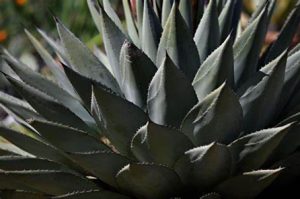By Debbie Roland and
Emmy Ulmschneider
Master Gardeners
When we think of agaves, we commonly think of the large perennial succulents, that we call century plants. But those agaves are only one part of a very diverse family, Agavaceae. This family has about 200 species in the southwest and they are very much a part of our native West Texas landscape and our home landscapes.
Our native agaves tolerate our hot climate, dry soils and limited rainfall. When you drive from here to the Big Bend, you look out upon the yuccas, sotols, nolinas, and lechuguillas that form part of our desert landscape.
Agaves are characterized by their rosettes of thick linear to lanceolate spine tipped leaves at ground level. Agaves have provided food, fiber, and medicine and building materials to humans for thousands of years. Today, we are most familiar with culinary agave products like tequila and agave syrup.
There are many readily available cultivated century plants with a range of heat and cold tolerances. Perhaps the most recognizable one is Agave americana, which is heat and cold tolerant and grows well in poor soil. It can take from five to fifty (but not a hundred) years for an agave to flower but is well worth the wait. The flower is spectacular and inspired the genus name which comes from the Greek word agauos meaning admirable or noble and the flower spikes are just that.

After the plant blooms it produces off shoots called pups and the mother plant slowly dies. These plants can grow up to 6’ wide and 13’ tall depending on the sun exposure and care. They shouldn’t be placed closed to sidewalks or driveways because the large leaves are sharp. Fall or late winter is the best time to plant them. They require deep and infrequent watering and can tolerate dry soils and drought.
In a landscape, large agaves are at their best as accent plant; smaller species such as Lechuguilla could be used as a ground cover in desert landscaping especially where a barrier is needed.
Small and medium species of agaves grow well in containers or planted with wildflowers or wild grasses. Be sure to plant in a container large enough for the root system to grow many years. Use a cactus type potting soil; root rot can develop in poorly draining soils.
If you are not familiar with century plants, you may be familiar with other members of this family that are readily available and used commonly in our landscapes. Look for native yuccas species such as Soapweed Yucca, Yucca glauca, Spanish Dagger, Yucca aloifolia, or Soft Leaf Yucca, Yucca recurvifolia. Red Yucca, Hesperaloe parviflora, although not a true yucca is a popular landscape plant available in several colors from red to pale pink.
My favorite agave is Sacahuista, Nolina texana, and someday I may even try making a basket from its leaves!
So, if you want to incorporate history, a sense of place and beauty into your garden, check out the agave family!
If you have questions, call the AgriLife office in Odessa at 498-4071 or in Midland at 686-4700.
Additional information, and our blog for access to past articles, is available at westtexasgardening.org. Click on “Resources.”




